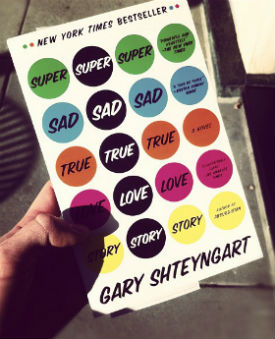 After finishing Gary Shteyngart’s Super Sad True Love Story a few weeks ago, I was struck by how intimately he had thought through the impact of technology on human relationships. His book anticipates the evolution of Facebook, as well as the descendants of devices such as the iPhone and yet-to-be-released Google glasses. The novel also picks apart the nuances of shared information, how credit scores and health records could define us publicly, and even what those details would mean in a world where biological immortality is an achievable (if prohibitively expensive) dream.
After finishing Gary Shteyngart’s Super Sad True Love Story a few weeks ago, I was struck by how intimately he had thought through the impact of technology on human relationships. His book anticipates the evolution of Facebook, as well as the descendants of devices such as the iPhone and yet-to-be-released Google glasses. The novel also picks apart the nuances of shared information, how credit scores and health records could define us publicly, and even what those details would mean in a world where biological immortality is an achievable (if prohibitively expensive) dream.
For tech geeks, as well as story lovers, there is a lot to digest in Shteyngart’s complex brink-of-collapse society. I wouldn’t want to spoil the political speculation and Chinese lending consequences that he also explores, but if you haven’t read SSTLS yet, here are five technologies that are present in the book and why the author’s vision for them may be worth your time.
1. Äppäräti, the PC evolved — As phones and tablets become more and more like out laptops and desktop PCs, the question of how many devices the average consumer will own and what they will look like is a valid one. In SSTLS, Shteyngart envisions something along the lines of Google’s glasses. There is a line at one point where a character makes fun of an outdated äppärät model by comparing it to an iPhone, clearly poking fun at how quickly our personal devices become outdated, but also positioning the äppärät as a replacement for smartphones. The gizmo is a networked link to the world, which also broadcasts information about the owner, whether they are looking for a restaurant or sizing up other singles in a bar. It’s the gateway to augmented reality fully realized.
2. GlobalTeens, the all-purpose network and communication platform — It wasn’t all that long ago that Facebook was just a site for college students looking to check out pictures of their friends and talk about classes. Shteyngart pokes fun at this evolution with SSTLS‘s Facebook analogue, which is called GlobalTeens. Although the name implies a young, immature audience, “Teening” (the verb for communicating over the network) is an activity that replaces instant messaging and email. If you want to call someone or talk to them in person, it means you want to “verbal.” The vocabulary from the book is hilarious and thought-provoking in this regard.
3. Socialized credit scores and health records, info habits that make “oversharing” seem like a word that only stodgy people use — Of all the practices and gadgets that change how people understand themselves in SSTLS, none are more eye-opening than the standard profiles available to complete strangers. You can imagine that single people are quite a bit more conscious of prospective mates’ credit scores in a world where everyone in the U.S. is over their heads in debt, but beyond that, everyone in the room can have a look at your health status and size up your probable lifespan. Most of these things would be totally doable via a smartphone app right now if users were willing, which just makes SSTL all the more believable.
4. The state of online shopping — Hand in hand with the äppärät, shopping for people who have money is a universally accessible option that allows purchases to be made anywhere and everywhere. There was also a brief moment where Lenny showcased the ease of cash transfers. Not wanting to accept money from Eunice’s father, he quickly transfers dollars straight into the man’s bank account. Services like Square and Paypal are already on top of options like this (and banks in many countries know that this is a convenience people want).
5. Post-Human Services, info habits that make “oversharing” seem like a word that stodgy people use — Lenny, the main character in SSTL, works for a company called Staatling-Wapachung, and his job is to sell life extension services to the world’s super-wealthy. Appropriately, the possibility of living forever impacts numerous other dimensions of day-to-day living. Everyone (including Lenny) seems bent on one-upping everyone else, devising a calculus of nutritional and financial choices that will let them live long enough to save up enough to afford extreme and indefinite life spans.
2 thoughts on “5 technologies explored in Shteyngart’s ‘Super Sad True Love Story’”